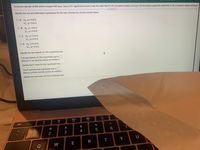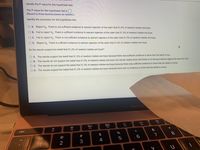
MATLAB: An Introduction with Applications
6th Edition
ISBN: 9781119256830
Author: Amos Gilat
Publisher: John Wiley & Sons Inc
expand_more
expand_more
format_list_bulleted
Question

Transcribed Image Text:A random sample of 836 births included 429 boys. Use a 0.01 significance level to test the claim that 51.2% of newborn babies are boys. Do the results support the belief that 51.2% of newborn babies are boys?
Identify the null and alternative hypotheses for this test. Choose the correct answer below.
.....
O A. Ho: p=0.512
Hq:p>0.512
O B. Ho:p=0.512
Hq:p<0.512
OC. Ho: p=0.512
H4:p#0.512
O D. Ho: p#0.512
Hy:p=0.512
Identify the test statistic for this hypothesis test.
The test statistic for this hypothesis test is.
(Round to two decimal places as needed.)
Identify the P-value for this hypothesis test.
The P-value for this hypothesis test is
(Round to three decimal places as needed.)
Identifv the conclusion for this hvpothesis test.
LEGO
20
000
F6
F5
esc
F3
F4
F1
F2
#
$
7
2
3
4
5
Q
W
E
R

Transcribed Image Text:Identify the P-value for this hypothesis test.
The P-value for this hypothesis test is
(Round to three decimal places as needed.)
Identify the conclusion for this hypothesis test.
O A. Reject Ho. There is not sufficient evidence to warrant rejection of the claim that 51.2% of newborn babies are boys.
B. Fail to reject Ho. There is sufficient evidence to warrant rejection of the claim that 51.2% of newborn babies are boys.
O C. Fail to reject Ho. There is not sufficient evidence to warrant rejection of the claim that 51.2% of newborn babies are boys.
D. Reject Ho: There is sufficient evidence to warrant rejection of the claim that 51.2% of newborn babies are boys.
Do the results support the belief that 51.2% of newborn babies are boys?
A. The results support the belief that 51.2% of newborn babies are boys because there was sufficient evidence to show that the belief is true.
B. The results do not support the belief that 51.2% of newborn babies are boys; the results merely show that there is not strong evidence against the rate of 51.2%.
C. The results do not support the belief that 51.2% of newborn babies are boys because there was sufficient evidence to show that the belief is untrue.
D. The results support the belief that 51.2% of newborn babies are boys because there was no evidence to show that the belief is untrue.
MacBook
F7
000
F6
F5
F4
F3
esc
F2
F1
&
#
24
%
7
8.
3
4
5
2
Y
Expert Solution
This question has been solved!
Explore an expertly crafted, step-by-step solution for a thorough understanding of key concepts.
This is a popular solution
Trending nowThis is a popular solution!
Step by stepSolved in 2 steps with 2 images

Knowledge Booster
Similar questions
- Consider a drug testing company that provides a test for marijuana usage. Among 308 tested subjects, results from 28 subjects were wrong (either a false positive or a false negative). Use a 0.10 significance level to test the claim that less than 10 percent of the test results are wrong. Identify the null and alternative hypotheses for this test. Choose the correct answer below. .... O A. Ho: p=0.1 H1: p#0.1 О в. Но р30.1 H: p>0.1 O C. Ho: p<0.1 H:p=0.1 O D. Ho: p=0.1 H4:p<0.1 Identify the test statistic for this hypothesis test. The test statistic for this hypothesis test is (Round to two decimal places as needed.) Identify the P-value for this hypothesis test. The P-value for this hypothesis test is (Round to three decimal places as needed.) Identify the conclusion for this hypothesis test. O A. Fail to reject H. There is sufficient evidence to warrant support of the claim that less than 10 percent of the test results are wrong. O B. Fail to reject Ho. There is not sufficient…arrow_forwardYou wish to test the following claim (Ha) at a significance level of a = 0.01. H.: u = 78.5 H.:u < 78.5 You believe the population is normally distributed, but you do not know the standard deviation. You obtain the following sample of data: data 64.5 63.5 72.4 68.2 58.3 65 What is the test statistic for this sample? (Report answer accurate to three decimal places.) test statistic = What is the p-value for this sample? (Report answer accurate to four decimal places.) p-value = The p-value is... O less than (or equal to) a O greater than aarrow_forwardcourses/50306/assignments/608635?module_item_id=1106150 You wish to test the following claim (Ha) at a significance level of a = 0.005. H.:µ = 59.4 Ha:u < 59.4 You believe the population is normally distributed, but you do not know the standard deviation. You obtain a sample of size n = 24 with mean M = 51.1 and a standard deviation of SD = 9.7. What is the p-value for this sample? (Report answer accurate to four decimal places.) p-value = The p-value is... O less than (or equal to) a O greater than a This p-value leads to a decision to... O reject the null O accept the null O fail to reject the null As such, the final conclusion is that... O There is sufficient evidence to warrant rejection of the claim that the population mean is less than 59.4. O There is not sufficient evidence to warrant rejection of the claim that the population mean is less than 59.4. O The sample data support the claim that the population mean is less than 59.4. OThere i not sufficient sample ovidence to…arrow_forward
- questions : "determine the null and alternative hypotheses" and the pnes below it.arrow_forwardAn online poll asked: "Do you believe the Loch Ness monster exists?" Among 22185 responses, 69%were "yes." Use a 0.10 significance level to test the claim that most people believe that the Loch Ness monster exists. How is the conclusion affected by the fact that Internet users who saw the question could decide whether to respond? Identify the null and alternative hypotheses for this test. Choose the correct answer below. A. H0: p>0.5 H1: p=0.5 B. H0: p=0.5 H1: p<0.5 C. H0: p=0.5 H1: p>0.5 D. H0: p=0.5 H1: p≠0.5 Part 2 Identify the test statistic for this hypothesis test. The test statistic for this hypothesis test is enter your response here. (Round to two decimal places as needed.) Part 3 Identify the P-value for this hypothesis test. The P-value for this hypothesis test is enter your response here. (Round to three decimal places as needed.) Part 4 Identify the conclusion for this hypothesis test.…arrow_forwarda. Identify the null and alternative hypotheses for this test. Choose the correct answer below. b. Identify the test statistic for this hypothesis test. c. The P-value for this hypothesis test is d. Identify the conclusion for this hypothesis test.arrow_forward
- The p-value for a hypothesis test turns out to be 0.03628. At a 9% level of significance, what is the proper decision? Reject Ho O Fail to reject Hoarrow_forwardThe p-value for a hypothesis test turns out to be 0.00956. At a 3% level of significance, what is the proper decision? O Reject Ho O Fail to reject Hoarrow_forwardAssume a significance level of a 0.05 and use the given information to complete parts (a) and (b) below Original claim: The proportion of male golfers is more than 0.9 The hypothesis test results in a P-value of 0 056. a. State a conclusion about the null hypothesis. (Reject H, or fail to reject H, ) Choose the corect answer below. O A. Fal to reject H, because the P-value is less than a OB. Fal to reject H, because the P-value in greater than it OC. Reject H, because the P-value is less than a OD. Reject Hg because the P-value is greater thanarrow_forward
- Assume a significance level of a = 0.05 and use the given information to complete parts (a) and (b) below. Original claim: More than 58% of adults would erase all of their personal information online if they could. The hypothesis test results in a P-value of 0.1921. a. State a conclusion about the null hypothesis. (Reject Ho or fail to reject Ho.) Choose the correct answer below. O A. Reject Ho because the P-value is greater than a. O B. Reject Ho because the P-value is less than or equal to a. O C. Fail to reject Ho because the P-value is less than or equal to a. O D. Fail to reject Ho because the P-value is greater than a. b. Without using technical terms, state a final conclusion that addresses the original claim. Which of the following is the correct conclusion? O A. There is sufficient evidence to support the claim that the percentage of adults that would erase all of their personal information online if they could is more than 58%. O B. There is not sufficient evidence to support…arrow_forwardThe percentage of complete passes is an important measure for a quarterback in the NFL. A particular quarterback has a career completion percentage of 55%. The quarterback got a new coach and then played a few games where he completed 48 of 100 passes. a. Specify the null and alternative hypotheses to determine whether the proportion of completed passes has decreased with the new coach. b. Calculate the value of the test statistic and the p-value. c. At the 5% significance level, can you conclude that the quarterback's completion percentage has decreased? How do I solve this in excel?arrow_forward
arrow_back_ios
arrow_forward_ios
Recommended textbooks for you
 MATLAB: An Introduction with ApplicationsStatisticsISBN:9781119256830Author:Amos GilatPublisher:John Wiley & Sons Inc
MATLAB: An Introduction with ApplicationsStatisticsISBN:9781119256830Author:Amos GilatPublisher:John Wiley & Sons Inc Probability and Statistics for Engineering and th...StatisticsISBN:9781305251809Author:Jay L. DevorePublisher:Cengage Learning
Probability and Statistics for Engineering and th...StatisticsISBN:9781305251809Author:Jay L. DevorePublisher:Cengage Learning Statistics for The Behavioral Sciences (MindTap C...StatisticsISBN:9781305504912Author:Frederick J Gravetter, Larry B. WallnauPublisher:Cengage Learning
Statistics for The Behavioral Sciences (MindTap C...StatisticsISBN:9781305504912Author:Frederick J Gravetter, Larry B. WallnauPublisher:Cengage Learning Elementary Statistics: Picturing the World (7th E...StatisticsISBN:9780134683416Author:Ron Larson, Betsy FarberPublisher:PEARSON
Elementary Statistics: Picturing the World (7th E...StatisticsISBN:9780134683416Author:Ron Larson, Betsy FarberPublisher:PEARSON The Basic Practice of StatisticsStatisticsISBN:9781319042578Author:David S. Moore, William I. Notz, Michael A. FlignerPublisher:W. H. Freeman
The Basic Practice of StatisticsStatisticsISBN:9781319042578Author:David S. Moore, William I. Notz, Michael A. FlignerPublisher:W. H. Freeman Introduction to the Practice of StatisticsStatisticsISBN:9781319013387Author:David S. Moore, George P. McCabe, Bruce A. CraigPublisher:W. H. Freeman
Introduction to the Practice of StatisticsStatisticsISBN:9781319013387Author:David S. Moore, George P. McCabe, Bruce A. CraigPublisher:W. H. Freeman

MATLAB: An Introduction with Applications
Statistics
ISBN:9781119256830
Author:Amos Gilat
Publisher:John Wiley & Sons Inc

Probability and Statistics for Engineering and th...
Statistics
ISBN:9781305251809
Author:Jay L. Devore
Publisher:Cengage Learning

Statistics for The Behavioral Sciences (MindTap C...
Statistics
ISBN:9781305504912
Author:Frederick J Gravetter, Larry B. Wallnau
Publisher:Cengage Learning

Elementary Statistics: Picturing the World (7th E...
Statistics
ISBN:9780134683416
Author:Ron Larson, Betsy Farber
Publisher:PEARSON

The Basic Practice of Statistics
Statistics
ISBN:9781319042578
Author:David S. Moore, William I. Notz, Michael A. Fligner
Publisher:W. H. Freeman

Introduction to the Practice of Statistics
Statistics
ISBN:9781319013387
Author:David S. Moore, George P. McCabe, Bruce A. Craig
Publisher:W. H. Freeman